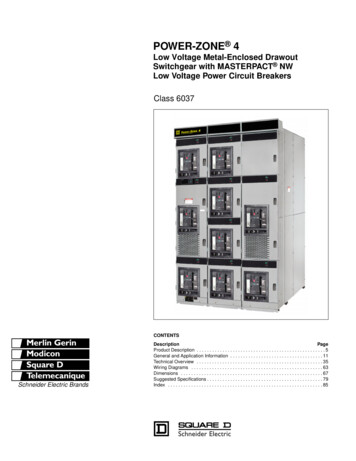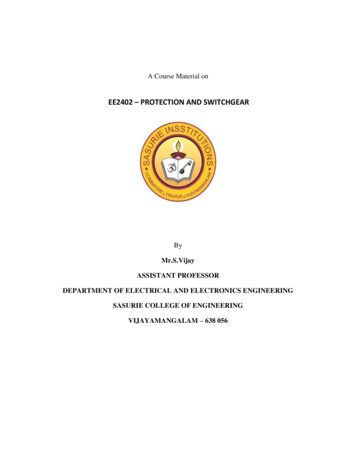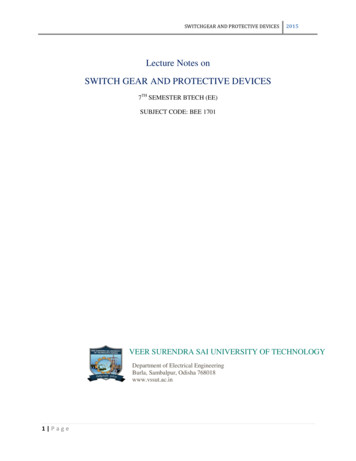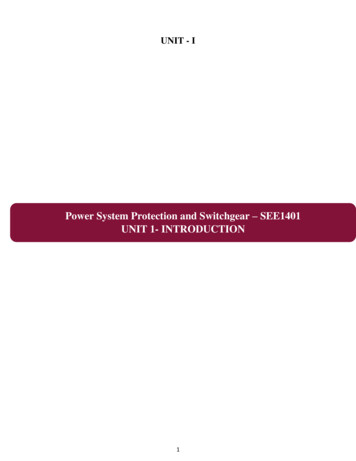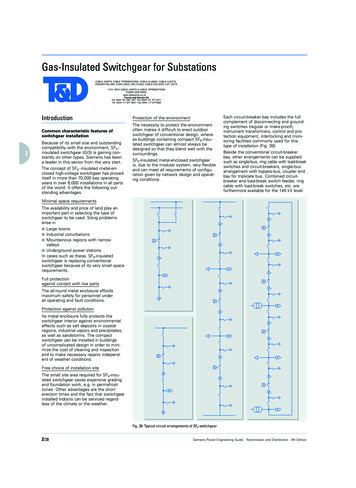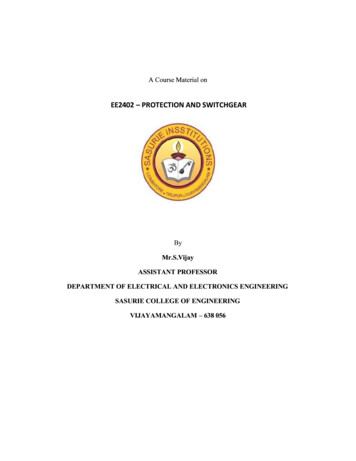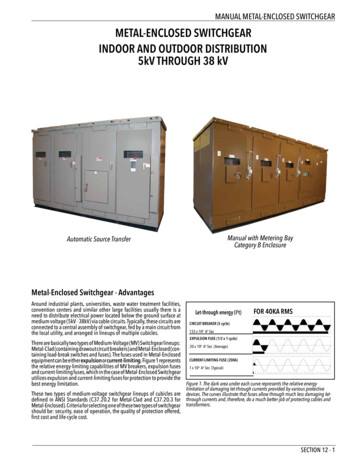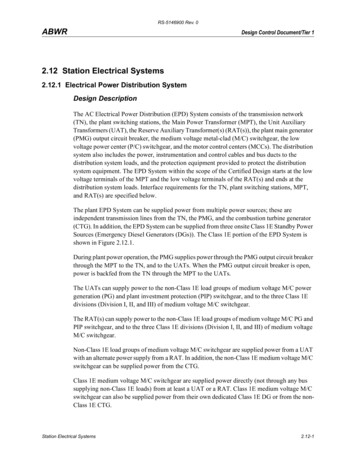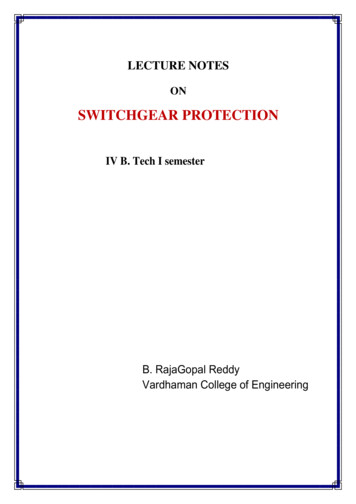
Transcription
LECTURE NOTESONSWITCHGEAR PROTECTIONIV B. Tech I semesterB. RajaGopal ReddyVardhaman College of Engineering
Circuit BreakerUNIT - IIntroduction:During the operation of power system, it is often desirable and necessary to switch on or off the variouscircuits (e.g., transmission lines, distributors, generating plants etc.) under both normal and abnormal conditions.In earlier days, this function used to be performed by a switch and a fuse placed in series with the circuit.However, such a means of control presents two disadvantages.1.Firstly, when a fuse blows out, it takes quite sometime to replace it and restore supply to the customers.2.Secondly, a fuse cannot successfully interrupt heavy fault currents that result from faults on modern highvoltage and large capacity circuits. Due to these disadvantages, the use of switches and fuses is limited to low voltage and small capacity circuitswhere frequent operations are not expected e.g., for switching and protection of distribution transformers,lighting circuits, branch circuits of distribution lines etc. With the advancement of power system, the lines and other equipment operate at very high voltages and carrylarge currents. The arrangement of switches along with fuses cannot serve the desired function of switchgearin such high capacity circuits. This necessitates employing a more dependable means of control such as isobtained by the use of circuit breakers. A circuit breaker can make or break a circuit either manually or automatically under all conditions viz., noload, full-load and short-circuit conditions. This characteristic of the circuit breaker has made it very useful equipment for switching and protection ofvarious parts of the power system. A circuit breaker is a piece of equipment which can(i) Make or break a circuit either manually or by remote control under normal conditions.(ii) Break a circuit automatically under fault conditions(iii) Make a circuit either manually or by remote control under fault conditionsThus a circuit breaker incorporates manual (or remote control) as well as automatic control for switchingfunctions. The latter control employs relays and operates only under fault conditions.
Operating principle:A circuit breaker essentially consists of fixed and moving contacts, called Electrodes. Under normaloperating conditions, these contacts remain closed and will not open automatically until and unless the systembecomes faulty. Of course, the contacts can be opened manually or by remote control whenever desired. When afault occurs on any part of the system, the trip coils of the circuit breaker get energized and the moving contactsare pulled apart by some mechanism, thus opening the circuit. When the contacts of a circuit breaker are separated under fault conditions, an arc is struck between them. Thecurrent is thus able to continue until the discharge ceases. The production of arc not only delays the current interruption process but it also generates enormous heatwhich may cause damage to the system or to the circuit breaker itself. Therefore, the main problem in a circuit breaker is to extinguish the arc within the shortest possible time sothat heat generated by it may not reach a dangerous value.Arc Phenomenon:When a short circuit occurs, a heavy current flows through the contacts of the circuit breaker before theyare opened by the protective system. At the instant when the contacts begin to separate, the contact area decreasesrapidly and large fault current causes increased current density and hence rise in temperature. The heat producedin the medium between contacts (usually the medium is oil or air) Is sufficient to ionize the air or vaporize andionize the oil. The ionized air or vapor acts as conductor and an arc is struck between the contacts. The potential difference between the contacts is quite small and is just sufficient to maintain the arc. The arc provides a low resistance path and consequently the current in the circuit remains UN interrupted solong as the arc persists. During the arcing period, the current flowing between the contacts depends upon the arc resistance. Thegreater the arc resistance, the smaller the current that flows between the contacts.The arc resistance depends upon the following factors:1. Degree of ionization-the arc resistance increases with the decrease in the number of ionized particlesbetween the contacts.2. Length of the arc— the arc resistance increases with the length of the arc i.e., separation of contacts.3. Cross-section of arc— the arc resistance increases with the decrease in area of X-section of the arc.
Principles of Arc Extinction:Before discussing the methods of arc extinction, it is necessary to examine the factors responsible for themaintenance of arc between the contacts. These are:1. Potential difference between the contacts.2. Ionized particles between contacts taking these in turn. When the contacts have a small separation, the Potential difference between them is sufficient to maintainthe arc. One way to extinguish the arc is to separate the contacts to such a distance that Potentialdifference becomes inadequate to maintain the arc. However, this method is impracticable in high voltagesystem where a separation of many meters may be required. The ionized particles between the contacts tend to maintain the arc. If the arc path is demonized, the arcextinction will be facilitated. This may be achieved by cooling the arc or by bodily removing the ionizedparticles from the space between the contacts.Methods of Arc Extinction (or) Interruption:There are two methods of extinguishing the arc in circuit breakers viz.1. High resistance method.2. Low resistance or current zero methodHigh resistance method:In this method, arc resistance is made to increase with time so that current is reduced to a value insufficientto maintain the arc. Consequently, the current is interrupted or the arc is extinguished. The principal disadvantage of this method is that enormous energy is dissipated in the arc. Therefore, it isemployed only in D.C. circuit breakers and low-capacity a.c. circuit breakers.The resistance of the arc may be increased by:1. Lengthening the arc: The resistance of the arc is directly proportional to its length. The length of the arc canbe increased by increasing the gap between contacts.2. Cooling the arc: Cooling helps in the deionization of the medium between the contacts. This increases thearc resistance. Efficient cooling may be obtained by a gas blast directed along the arc.
3. Reducing X-section of the arc: If the area of X-section of the arc is reduced, the voltage necessary tomaintain the arc is increased. In other words, the resistance of the arc path is increased. The cross-section ofthe arc can be reduced by letting the arc pass through a narrow opening or by having smaller area of contacts.4. Splitting the arc: The resistance of the arc can be increased by splitting the arc into a number of smaller arcsin series. Each one of these arcs experiences the effect of lengthening and cooling. The arc may be split byintroducing some conducting plates between the contacts.Low resistance or Current zero method:In this method is employed for arc extinction in a.c. circuits only. In this method, arc resistance is keptlow until current is zero where the arc extinguishes naturally and is prevented from restriking in spite of the risingvoltage across the contacts. All Modern high power a.c. circuit breakers employ this method for arc extinction. In an a.c. system, current drops to zero after every half-cycle. At every current zero, the arc extinguishesfor a brief moment. Now the medium between the contacts contains ions and electrons so that it has small dielectric strengthand can be easily broken down by the rising contact voltage known as restriking voltage. If such a breakdown does occur, the arc will persist for another half cycle. If immediately after current zero, the dielectric strength of the medium between contacts is built up morerapidly than the voltage across the contacts, the arc fails to restrike and the current will be interrupted.The rapid increase of dielectric strength of the medium near current zero can be achieved by: Causing the ionized particles in the space between contacts to recombine into neutral molecules. Sweeping the ionized particles away and replacing them by un ionized particles.Therefore, the real problem in a.c. arc interruption is to rapidly de ionize the medium between contacts assoon as the current becomes zero so that the rising contact voltage or restriking voltage cannot breakdown thespace between contacts.The de-ionization of the medium can be achieved by:1.Lengthening of the gap: The dielectric strength of the medium is proportional to the length of the gapbetween contacts. Therefore, by opening the contacts rapidly, higher dielectric strength of the medium can beachieved.
2.High pressure: If the pressure in the vicinity of the arc is increased, the density of the particles constitutingthe discharge also increases. The increased density of particles causes higher rate of de-ionization andconsequently the dielectric strength of the medium between contacts is increased.3.Cooling: Natural combination of ionized particles takes place more rapidly if they are allowed to cool.Therefore, dielectric strength of the medium between the contacts can be increased by cooling the arc.4.Blast effect: If the ionized particles between the contacts are swept away and replaced by UN ionizedparticles, the dielectric strength of the medium can be increased considerably. This may be achieved by a gasblast directed along the discharge or by forcing oil into the contact space.There are two theories to explain the Zero current interruption of the Arc:1.Recovery rate theory (Slepain‘s Theory)2.Energy balance theory (Cassie‘s Theory)Recovery rate theory (Slepain’s Theory):The arc is a column of ionized gases. To extinguish the arc, the electrons and ions are to be removed fromthe gap immediately after the current reaches a natural zero. Ions and electrons can be removed either byrecombining them in to neutral molecules or by sweeping them away by inserting insulating medium (gas orliquid) into the gap. The arc is interrupted if ions are removed from the gap recovers its dielectric strength iscompared with the rate at which the restriking voltage (transient voltage) across the gap rises. If the dielectricstrength increases more rapidly than the restriking voltage, the arc is extinguished. If the restriking voltage risesmore rapidly than the dielectric strength, the ionization persists and breakdown of the gap occurs, resulting in anarc for another half cycle.
Energy balance theory (Cassie’s Theory):The space between the contacts contains some ionized gas immediately after current zero and hence, ithas a finite post –zero moment, power is zero because restriking voltage is zero. When the arc is finallyextinguished, the power gain becomes zero, the gap is fully de-ionized and its resistance is infinitely high. Inbetween these two limits, first the power increases, reaches a maximum value, then decreases and finitely reacheszero value as shown in figure. Due to the rise of restriking voltage and associated current, energy is generated inthe space between the contacts. The energy appears in the form of heat. The circuit breaker is designed to removethis generated heat as early as possible by cooling the gap, giving a blast air or flow of oil at high velocity andpressure. If the rate of removal of heat is faster than the rate of heat generation the arc is extinguished. If the rateof heat generation is more than the rate of heat dissipation, the space breaks down again resulting in an arc foranother half cycle.
Important Terms:The following are the important terms much used in the circuit breaker analysis:1.Arc Voltage:It is the voltage that appears across the contacts of the circuit breaker during the arcing period. As soon asthe contacts of the circuit breaker separate, an arc is formed. The voltage that appears across the contacts duringarcing period is called the arc voltage. Its value is low except for the period the fault current is at or near zerocurrent point. At current zero, the arc voltage rises rapidly to peak value and this peak voltage tends to maintainthe current flow in the form of arc.2.Restriking voltage:It is the transient voltage that appears across the contacts at or near current zero during arcing period. Atcurrent zero, a high-frequency transient voltage appears across the contacts and is caused by the rapiddistribution of energy between the magnetic and electric fields associated with the plant and transmission lines ofthe system. This transient voltage is known as restriking voltage (Fig. 19.1).The current interruption in the circuit depends upon this voltage. If the restriking voltage rises morerapidly than the dielectric strength of the medium between the contacts, the arc will persist for another half-cycle.On the other hand, if the dielectric strength of the medium builds up more rapidly than the restriking voltage, thearc fails to restrike and the current will be interrupted.3.Recovery voltage:It is the normal frequency (50 Hz) R.M.S. voltage that appears across the contacts of the circuit breakerafter final arc extinction. It is approximately equal to the system voltage.
When contacts of circuit breaker are opened, current drops to zero after every half cycle. At some currentzero, the contacts are separated sufficiently apart and dielectric strength of the medium between the contactsattains a high value due to the removal of ionized particles. At such an instant, the medium between the contactsis strong enough to prevent the breakdown by the restriking voltage. Consequently, the final arc extinction takesplace and circuit current is interrupted. Immediately after final current interruption, the voltage that appears acrossthe contacts has a transient part (See Fig.19.1). However, these transient oscillations subside rapidly due to thedamping effect of system resistance and normal circuit voltage appears across the contacts. The voltage across thecontacts is of normal frequency and is known as recovery voltage.Expression for Restriking voltage and RRRV:The power system contains an appreciable amount of inductance and some capacitance. When a faultoccurs, the energy stored in the system can be considerable. Interruption of fault current by a circuit breaker willresult in most of the stored energy dissipated within the circuit breaker, the remainder being dissipated duringoscillatory surges in the system. The oscillatory surges are undesirable and, therefore, the circuit breaker must bedesigned to dissipate as much of the stored energy as possible.
Fig. 19.17 (i) shows a short-circuit occurring on the transmission line. Fig 19.17 (ii) shows its equivalent circuitwhere L is the inductance per phase of the system up to the point of fault and C is the capacitance per phase of thesystem. The resistance of the system is neglected as it is generally small.Rate of rise of re-striking voltage:It is the rate of increase of re-striking voltage and is abbreviated by R.R.R.V. usually; the voltage is in kVand time in microseconds so that R.R.R.V. is in kV/µ sec.Consider the opening of a circuit breaker under fault conditions Shown in simplified form in Fig. 19.17(ii) above. Before current interruption, the capacitance C is short-circuited by the fault and the short-circuitcurrent through the breaker is limited by Inductance L of the system only. Consequently, the short-circuit currentwill lag the voltage by 90º as shown in Fig. 19.18, where I Represents the short-circuit current and ea representsthe arc voltage. It may be seen that in this condition, the *entire generator voltage appears across inductance L.
When the contacts are opened and the arc finally extinguishes at some current zero, the generator voltagee is suddenly applied to the inductance and capacitance in series.1This L - C combination forms an oscillatory circuit and produces a transient of frequency: fn 2ΠLCThe voltage across the capacitance which is the voltage across the contacts of the circuit breaker can becalculated in terms of L, C, fn and system voltage. The mathematical expression for transient condition is asfollows.As vc(t) 0 at t 0, constant 0vc(t) E(1-coswnt) or vc(t) E(1-cos1𝐿𝐶t) Restriking voltageThe maximum value of restriking voltage 2Epeak 2 X Peak value of system voltageThe rate of rise of restriking voltage (RRRV) 𝑑𝐸𝑑𝑇(1 cos wn t) wn E sinwntThe maximum value of RRRV wn E wn EpeakWhich appears across the capacitor C and hence across the contacts of the circuit breaker. This transientvoltage, as already noted, is known as re-striking voltage and may reach an instantaneous peak value twice thepeak phase-neutral voltage i.e. 2 Em . The system losses cause the oscillations to decay fairly rapidly but the initialovershoot increases the possibility of re-striking the arc.It is the rate of rise of re-striking voltage (R.R.R.V.) which decides whether the arc will re-strike or not. IfR.R.R.V. is greater than the rate of rise of dielectric strength between the contacts, the arc will re-strike. However,the arc will fail to re-strike if R.R.R.V. is less than the rate of increase of dielectric strength between the contactsof the breaker.The value of R.R.R.V. depends up on:1. Recovery voltage2. Natural frequency of oscillationsFor a short-circuit occurring near the power station bus-bars, C being small, the natural frequency fn willbe high. Consequently, R.R.R.V. will attain a large value. Thus the worst condition for a circuit breaker would bethat when the fault takes place near the bus-bars.
Current chopping:It is the phenomenon of current interruption before the natural current zero is reached. Current choppingmainly occurs in air-blast circuit breakers because they retain the same extinguishing power irrespective of themagnitude of the current to be interrupted. When breaking low currents (e.g., transformer magnetizing current)with such breakers, the powerful de-ionizing effect of air-blast causes the current to fall abruptly to zero wellbefore the natural current zero is reached. This phenomenon is known as current chopping and results in theproduction of high voltage transient across the contacts of the circuit breaker as discussed below:Consider again Fig. 19.17 (ii) repeated as Fig. 19.19 (i). Suppose the arc current is i when it is choppeddown to zero value as shown by point a in Fig. 19.19 (ii). As the chop occurs at current i, therefore, the energystored in inductance is L i2 /2.This energy will be transferred to the capacitance C, charging the latter to a prospective voltage e given by:Li 22 Cv 22(or)v iLCvoltsThe prospective voltage e is very high as compared to the dielectric strength gained by the gap so that thebreaker restrike. As the de-ionizing force is still in action, therefore, chop occurs again but the arc current thistime is smaller than the previous case. This induces a lower prospective voltage to re-ignite the arc. In fact,several chops may occur until a low enough current is interrupted which produces insufficient induced voltage tore-strike across the breaker gap. Consequently, the final interruption of current takes place.Excessive voltage surges due to current chopping are prevented by shunting the contacts of the breakerwith a resistor (resistance switching) such that re ignition is unlikely to occur. This is explained in Art 19.19.
Capacitive current breaking:Another cause of excessive voltage surges in the circuit breakers is the interruption of capacitive currents.Examples of such instances are opening of an unloaded long transmission line, disconnecting a capacitor bankused for power factor improvement etc. Consider the simple equivalent circuit of an unloaded transmission lineshown in Fig.19.20. Such a line, although unloaded in the normal sense, will actually carry a capacitive current Ion account of appreciable amount of capacitance C between the line and the earth.Let us suppose that the line is opened by the circuit breaker at the instant when line capacitive current iszero [point 1 in Fig. 19.21. At this instant, the generator voltage V g will be maximum (i.e. V gm) lagging behindthe current by 90º. The opening of the line leaves a standing charge on it (i.e., end B of the line) and the capacitorC1 is charged to V gm. However, the generator end of the line (i.e., end A of the line) continues its normalsinusoidal variations. The voltage V r across the circuit breaker will be the difference between the voltages on therespective sides. Its initial value is zero (point 1) and increases slowly in the beginning. But half a cycle later[point R in Fig. 19.21], the potential of the circuit breaker contact ‗A ‘ becomes maximum negative which causesthe voltage across the breaker (V r) to become 2 V gm. This voltage may be sufficient to restrike the arc. The twopreviously separated parts of the circuit will now be joined by an arc of very low resistance. The line capacitancedischarges at once to reduce the voltage across the circuit breaker, thus setting up high frequency transient. Thepeak value of the initial transient will be twice the voltage at that instant i.e., 4 V gm. This will cause thetransmission voltage to swing to 4V gm to V gm i.e., 3V gm.The re-strike arc current quickly reaches its first zero as it varies at natural frequency. The voltage on theline is now 3 Vgm and once again the two halves of the circuit are separated and the line is isolated at thispotential. After about half a cycle further, the aforesaid events are repeated even on more formidable scale and theline may be left with a potential of 5V gm above earth potential. Theoretically, this phenomenon may proceed
infinitely increasing the voltage by successive increment of 2 times V gm.While the above description relates to the worst possible conditions, it is obvious that if the gapbreakdown strength does not increase rapidly enough, successive re-strikes can build up a dangerous voltage inthe open circuit line. However, due to leakage and corona loss, the maximum voltage on the line in such cases islimited to 5 V gm.Resistance Switching:It has been discussed above that current chopping, capacitive current breaking etc. give rise to severevoltage oscillations. These excessive voltage surges during circuit interruption can be prevented by the use ofshunt resistance R connected across the circuit breaker contacts as shown in the equivalent circuit in Fig. 19.22.This is known as resistance switching.Referring to Fig. 19.22, when a fault occurs, the contacts of the circuit breaker are opened and an arc isstruck between the contacts. Since the contacts are shunted by resistance R, a part of arc current flows throughthis resistance. This results in the decrease of arc current and an increase in the rate of de-ionization of the arcpath. Consequently, the arc resistance is increased. The increased arc resistance leads to a further increase incurrent through shunt resistance. This process continues until the arc current becomes so small that it fails tomaintain the arc. Now, the arc is extinguished and circuit current is interrupted.
The shunt resistor also helps in limiting the oscillatory growth of re-striking voltage. It can be provedmathematically that natural frequency of oscillations (or) the frequency of damped oscillation of the circuit shownin Fig. 19.22 is given by:The effect of shunt resistance R is to prevent the oscillatory growth of re-striking voltage and cause it togrow exponentially up to recovery voltage. This is being most effective when the value of R is so chosen that thecircuit is critically damped. The value of R required for critical damping is 0.5 𝐿𝐶 . Fig. 19.23 shows theoscillatory growth and exponential growth when the circuit is critically damped.To sum up, resistors across breaker contacts may be used to perform one or more of the following functions:1. To reduce the rate of rise of re-striking voltage and the peak value of re-striking voltage.2. To reduce the voltage surges due to current chopping and capacitive current breaking.3. To ensure even sharing of re-striking voltage transient across the various breaks in multi break circuitbreakers.It may be noted that value of resistance required to perform each function is usually different. However, it
is often necessary to compromise and make one resistor do more than one of these functions.Switchgear Components:The following are some important components common to most of the circuit breakers:1. Bushings2. Circuit breaker contacts3. Instrument transformers4. Bus-bars and conductorsBushings:When a high voltage conductor passes through a metal sheet or frame which is at earth potential, thenecessary insulation is provided in the form of bushing. The primary function of the bushing is to preventelectrical breakdown between the enclosed conductor and the surrounding earthed metal work. Fig. 19.13 (i)shows the use of bushing for a plain-break oil circuit breaker. The high voltage conductor passes through thebushing made of some insulating material (e.g., porcelain, steatite). Although there are several types of bushing(e.g., condenser type, oil filled etc.), they perform the same function of insulating the conductor from earthedtank. The failure of the bushing can occur in two ways. Firstly, the breakdown may be caused by puncture i.e.,dielectric failure of the insulating material of the bushing. Secondly, the breakdown may occur in the form of aflash-over between the exposed conductor at either end of the bushing and the earthed metal. Fig. 19.13 (ii)illustrates these two possibilities. The bushings are so designed that flash-over takes place before they getpunctured. It is because the puncture generally renders the bushing insulation unserviceable and incapable ofwithstanding the normal voltage. On the other hand, a flash-over may result in comparatively harmless burning ofthe surface of the bushing which can then continue to give adequate service pending replacement.
Circuit breaker contacts:The circuit breaker contacts are required to carry normal as well as short-circuit current. In carrying thenormal current, it is desirable that the temperature should not rise above the specified limits and that there shouldbe low voltage drop at the point of contact. In carrying breaking and making short-circuit currents, the chiefeffects to be dealt with are melting and Vaporization by the heat of the arc and those due to electromagneticforces. Therefore, the design of contacts is of considerable importance for satisfactory operation of the circuitbreakers. There are three types of circuit breaker contacts viz.(a) Tulip type contacts: Fig. 19.14 (i) shows the Tulip type contact. It consists of moving contact which movesinside the fixed contacts. At contact separation, the arc is generally established between the tips of the fixedcontacts and the tip of the moving contact as shown in Fig. 19.14 (ii). The advantage of this type of contact isthat arcing is confined to the regions which are not in contact in the fully engaged position.(b) Finger and wedge contacts: Fig. 19.15 (i) shows the finger and wedge type contact. Thistype of contact is
largely used for low-voltage oil circuit breakers owing to the general unsuitability for use with arc controldevices.(c) Butt contacts: Fig. 19.15 (ii) shows the butt type contact and is formed by the springs and the moving contact.It possesses two advantages. Firstly, spring pressure is available to assist contact separation. This is useful insingle-break oil circuit breakers and air-blast circuit breakers where relatively small ―loop‖ forces are available toassist in opening. Secondly, there is no grip force so that this type of contact is especially suitable for higher shortcircuit rating.Instrument transformers:In a modern power system, the circuits operate at very high voltages and carry current of thousands of amperes.The measuring instruments and protective devices cannot work satisfactorily if mounted directly on the powerlines. This difficulty is overcome by installing instrument transformers on the power lines. The function of theseinstrument transformers is to transform voltages or currents in the power lines to values which are convenient forthe operation of measuring instruments and relays.There are two types of instrument transformers viz.1. Current transformer (C.T.)2. Potential transformer (P.T.)The primary of current transformer is connected in the power line. The secondary winding provides for
the instruments and relays a current which is a constant fraction of the current in the line similarly, a potentialtransformer is connected with its primary in the power line. The secondary provides for the instruments and relaysa voltage which is a known fraction of the line voltage. Fig. 19.16 shows the use of instrument transformers. The*potential transformer rated 66,000/110V provides a voltage supply for the potential coils of voltmeter andwattmeter. The current transformer rated 1000/5 A supplies current to the current coils of wattmeter and ammeter.The use of instrument transformers permits the following advantages:(a)They isolate the measuring instruments and relays from high-voltage power circuits.(b)The leads in the secondary circuits carry relatively small voltages and currents. This permits to use wiresof smaller size with minimum insulation.Bus-bars and conductors: The current carrying members in a circuit breaker consist of fixed and movingcontacts and the conductors connecting these to the points external to the breaker. If the switchgear is of outdoortype, these connections are connected directly to the overhead lines. In case of indoor switchgear, the incomin
This characteristic of the circuit breaker has made it very useful equipment for switching and protection of various parts of the power system. A circuit breaker is a piece of equipment which can (i) Make or break a circuit either manually or by remote control under normal conditions.
